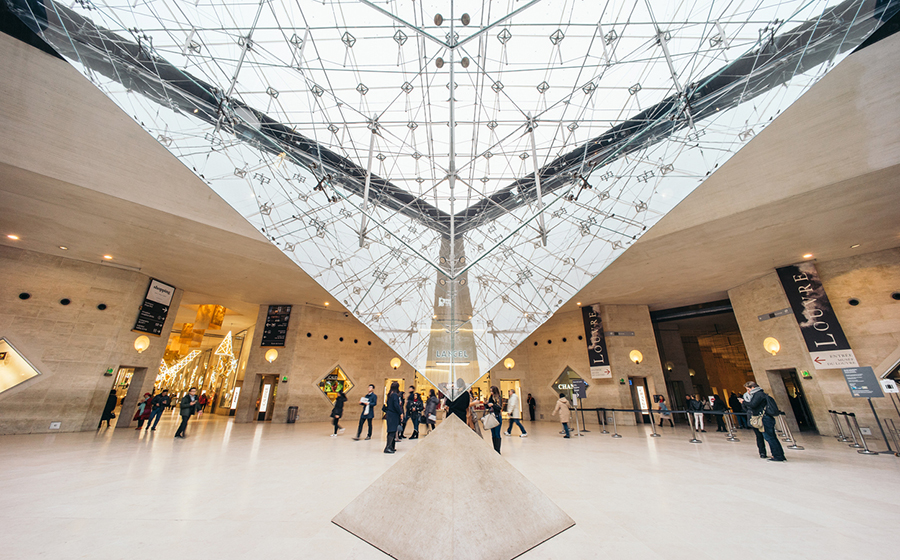I.M. Pei\’s recent death and consequent obituary in The New York Times puts us all in mind of his far-reaching impact. One of the typically unexplored consequences of his work is the process by which his 1987 pyramid at the Louvre augured more than a radical (and at least initially controversial) reimagining of historic architecture. By 1993, It had come to signal a new and remarkably vital exploration of context and content for the world of (wait for it) retail. And not incidentally, dining — fine and otherwise.
The first trip down his crystal palace\’s escalator send our eyes hurtling earthward and beneath, contrary to thinking this new light in the plaza would have raised our gaze more heavenward. Nope. We were going way down into the socio-quake known as the Carrousel du Louvre. The mall covers 10,200 square meters, with at last count 33 stores and 11 restaurants. All the usual suspects are there: Sephora, Swarovski, the first Apple Store in France, even a McDonald\’s. Zut alors et mon Dieu!
But when I say an exploration of content and context I am thinking about what it means to have a shopping arcade co-located within a museum, and a world-class museum at that. It may have been the Dalia Lama who said, \”The mall is the museum of the 21st century,\” but the corollary is proving to be more profoundly true. The museum is the mall.
Merchants of Cultural Excitement, pas Ennui
When we shop, we no longer want to go to the mall. We want an experience we can brag about, one that ennobles us. Aspiration plus inspiration. Museums offer that in sharp relief from any other retail format alive today. They are anything but boring. We\’re not shopping, we\’re learning. We\’re at a museum. We\’re not buying, we\’re curating. We\’re not eating in a food court, we\’re dining. These are selfie moments with a soupçon of good taste as their key ingredient.
Take a look at the impact on fashion, style and ultimately retail that the Metropolitan Museum and its fabulous annual Fashion Gala has to support the Costume Institute. An entire collection of apparel, accessories, and more was designed exclusively for The Met Store\’s Camp: Notes on Fashion collection – branding the show for retail consumption. The Camp experience is content ennobled by the context. Do we slither along with the hordes and hope to glimpse the world of Camp through the throngs of ticketholders this year? Not if we\’re members we don\’t. We\’re invited to private evening tours, member-priced memorabilia and all augmented by le diner après, featuring special menus at the Members and Patrons Dining Room. Membership has its privileges, and spending money is one of them!
It is arguable that once upon a different time the Fashion Gala fundraiser might have taken place at Lord & Taylor, Bergdorf Goodman or Barney\’s (Madison Avenue Barney\’s, that is). Once upon that same but different time, department and specialty retail vied for having exciting and cross-merchandisable events, even without the bling, televised arrivals and red carpet
Commerce as Culture as Couture
There\’s another aspect of the museum culture that has changed our notion of fashion. Museum-quality merchandise has taken hold and explains a great deal about our current retail conundrum: Look, don\’t touch. I recently sat at rapt attention through a two-hour presentation at the National Arts Club from the remarkable SCAD Ambassador Carmela Spinella on the work of Chinese couturier Guo Pei. We may all recall that gold embroidered, 25-foot long robe/coat/dress which was Rihanna\’s ticket to the 2015 Met Gala. Pei\’s work is currently moving through the museum circuit, having started at SCAD and now trudging west and then north. This is a designer whose works require 10,000 hours of hand beading, painting and design — a renaissance of Palace Embroidery skills feared lost after the Cultural Revolution. Her work is imagined and produced really for museum exhibition, rather than the more mundane concept of apparel. Her business model thus requires a basic retooling from the traditional designer brand approach. Pei and her husband have created a \”membership model,\” a twist on a museum\’s. A customer pays an annual, six-figure or so fee and gets a work of art she may indeed be able to wear to something before donating to, well yes, a museum.
This idea of fashion as serious fine art, as opposed to applied art, does indeed help escalate the price/value equation. Its museum context spikes the relevance quotient, for sure. At least for one Met Gala night a year. But it may also push the notion of what we wear to the margins. We\’re not going to be wearing the 55-pound dress, it\’s not to be actually worn, after all. What do we wear? Jeans and t-shirts. Perhaps some even purchased at the museum and worn there as well. There is no more sharp juxtaposition, no more stark contrast in retail today other than what is on display at the costume exhibits at museums. Just look at what we wear to look at what we\’re never going to wear. Costume shows rival the food voyeurism we see on display on the Food Channel, things we\’re never going to cook or eat, but we\’re charmed to watch someone else prepare. Some dare call it \”civil porn,\” observing and fetishizing over what we imagine demonstrates our engagement with bona fide cultural allure — all the while refusing to participate.
I.M. Pei\’s Retail Legacy
So back to I.M. Pei and his basement of the Louvre. Is there a place for Guo Pei? Or does retail just leave the high road to the museum and default to price promotion on jeans? We\’re left with more questions than answers, but what does emerge from the fog is that the trite refrain that \”shoppers want brands they can engage with\” may be true in an unexpected (and hard for retailers to monetize) way. We may want the common experience of a Starbucks, where we never speak with anyone other than the barista, the social anonymity of a darkened movie theatre, sharing the moment with strangers; the thundering screams and cheers of spectator sports and music festivals, nestled among presumed like-minded others; the days spent wandering museums with a private, recorded tutorial in our ears. But we don\’t want to dress up for them. And that is the death knell for much of fashion retail as we know it.
What we\’re willing to pay for increasingly is spectacle and self-aggrandizing selfies. Content within the right context. Hard to make that work in a mall. Quel dommage.




